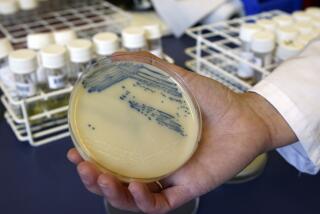Opinion: Killer superbugs are coming for you
- Share via
We’re crawling on your skin. Teeming under your toenails. And lurking on your doorknobs and countertops.
We’re drug-resistant microbes, immune to all but your strongest antibiotics. And we’re evolving so fast that soon even those medicines won’t stop us. Unless your scientists invent new antibiotics, we’ll kill 10 million people annually by 2050.
We didn’t always pose such a dire threat to mankind. In fact, antibiotics once threatened to eliminate our species. After your scientists developed these drugs in the 1920s, deaths from bacterial infections like pneumonia and cholera plummeted. In the United States, life expectancy jumped from 54 years in 1920 to almost 79 years today, according to Centers for Disease Control and Prevention statistics.
But over the years, your doctors prescribed the same treatments over and over — and we eventually evolved to resist them.
For instance, Bactrim, once a sure-fire cure for urinary tract infections, now can’t effectively treat a third of them. Ceftriaxone, an antibiotic that previously knocked out gonorrhea, often proves ineffective against the sexually transmitted infection. It’s so ineffective that the CDC recently changed nationwide treatment protocols, urging doctors to prescribe a second antibiotic simultaneously. And numerous drugs have failed against a superbug known as CRE, or carbapenem-resistant Enterobacteriaceae, a type of microbe that’s virtually untreatable.
All told, we drug-resistant microbes infect almost 3 million Americans each year and kill 162,000 of them.
Many of America’s leading scientists want to develop new treatments to wipe us out. But they’re struggling to attract financing for their work. The Food and Drug Administration has approved only one new class of antibiotics since the 1980s. As of September, drug companies were conducting just 42 antibiotics clinical trials worldwide. By comparison, they were testing thousands of experimental treatments for diseases such as cancer, Alzheimer’s and multiple sclerosis.
Why isn’t your scientific community pouring more resources into this fight? Frankly, the market discourages it.
Developing a new drug takes more than a decade and costs more than $2.5 billion.
Normally, your pharmaceutical companies would recoup those costs by selling new medicines in high volume.
But that sales model doesn’t work for advanced antibiotics. Your doctors would only prescribe new antibiotics in emergency cases. That’s a smart precaution, medically speaking — it minimizes our chances to evolve and become immune to the new drugs.
But financially speaking, those limited prescriptions sound the death knell for innovation. Drug companies wouldn’t be able to sell enough doses to recoup their research costs, let alone turn a profit.
This market failure explains why drug firms are throwing in the towel. Just last year, three major pharmaceutical companies halted antibiotic research. Firms are turning to more lucrative investments such as cancer research and heart disease.
Your policymakers still have time to fix the market. They could, for instance, offer market-entry rewards to firms that develop new antibiotics. One former chief economist at Goldman Sachs Group Inc. suggests offering a $1-billion reward to any company that creates a novel, FDA-approved antibiotic.
Policymakers could also reform reimbursements. Congress is considering a bill that would let Medicare offer higher payments to hospitals that use advanced antibiotics, when appropriate. That would enable hospitals to purchase newer antibiotics, boosting demand for such drugs and spurring biotech companies to pour more resources into R&D.
Unless your leaders act, we’ll continue growing stronger. Soon, we’ll achieve our goal — a world where antibiotics don’t work and millions die from simple infections.
Greg Frank is director of Working to Fight AMR, an organization funded by the biopharmaceutical industry that works to build support for antimicrobial drug development.
More to Read
A cure for the common opinion
Get thought-provoking perspectives with our weekly newsletter.
You may occasionally receive promotional content from the Los Angeles Times.










